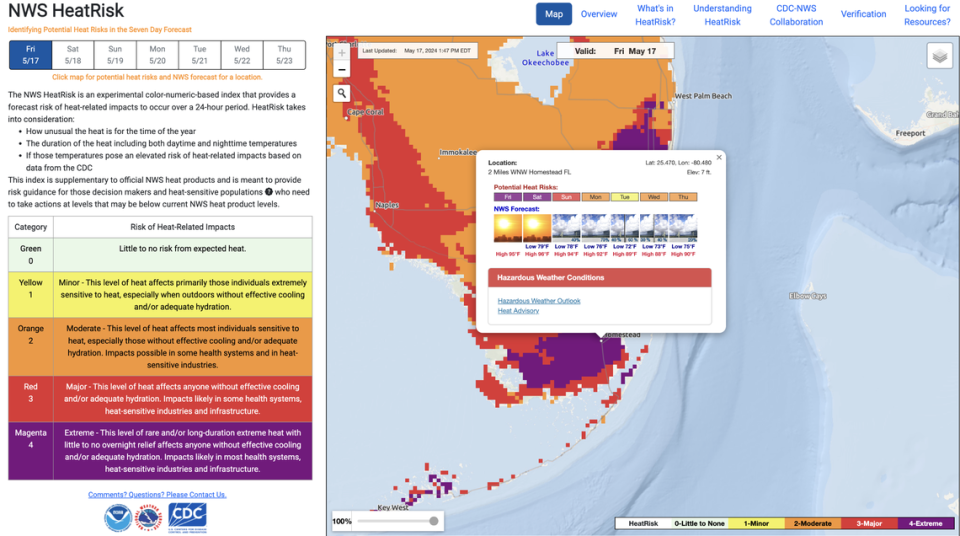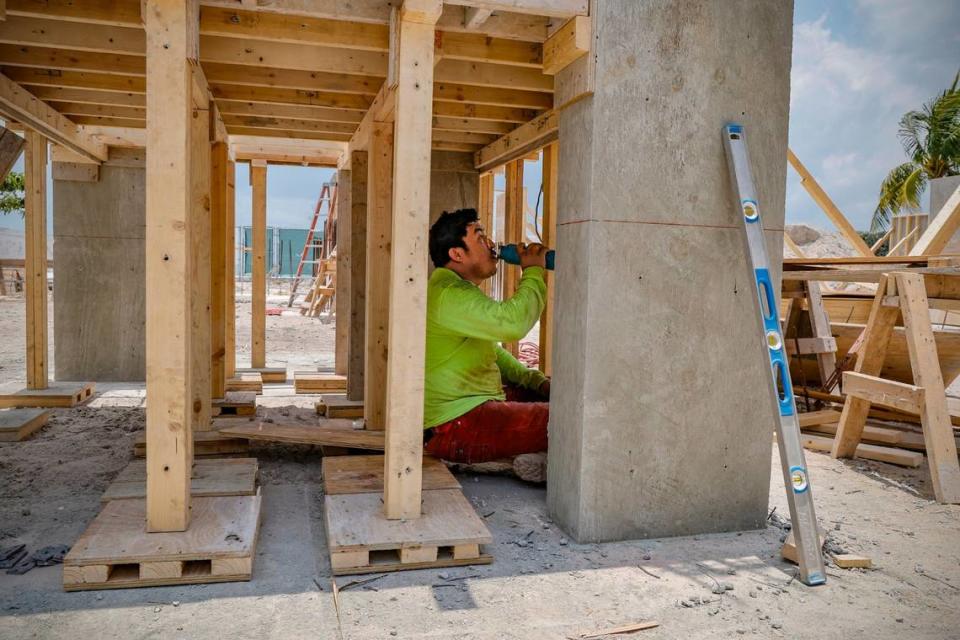When is it too hot to be outside? A new online tool will help you plan your week
An early-season heat wave is scorching Miami right now, and a new National Weather Service tool is designed to help people plan ahead and decide if it is too hot to work or be outside.
The NWS HeatRisk Tool, launched on Earth Day by the National Oceanic and Atmospheric Administration (NOAA) and Centers for Disease Control and Prevention (CDC), provides a seven-day forecast using a color-coded scale from green to magenta to tell you if a day is expected to be dangerously hot.
The new tool, which is in a trial phase, allows you to put in your address and see the local forecast with the heat information. If your area shows up as magenta, expect hotter-than-hot record-breaking temperatures. On Friday, much of Miami-Dade County was magenta with the first heat advisory of the year in effect.
“We have red, it’s hot, it’s dangerous, and then we have magenta for this is extremely dangerous,said Kimberly McMahon, the Public Weather Services program manager for NWS. “This is going to be impactful for absolutely everyone.”

Nearly 1,200 people die from heat every year, according to NOAA, and record-breaking heat waves fueled by climate change add to that threat.
Early-season heat events have some of the highest rates of heat illness and heat-related deaths because people are not prepared for it, McMahon said. The unexpected heat might not give people a chance to make sure the AC is serviced and the filter is cleaned. In other cases, people’s bodies may not have had enough time to adjust to the increasing heat outdoors.
The HeatRisk Tool shows the high and low-temperature forecast seven days out with the hope people can better prepare, and maybe even reschedule an outdoor activity for a cooler day.
The tool is different than a heat warning alert you might see on your phone from the National Weather Service because it combines the weather with historical data and context, including information from local medical providers and emergency responders about heat-related incidents. It also takes into account night-time temperatures. That’s important in Miami because it’s an urban heat island, with pavement and buildings absorbing and retaining heat.
“In the U.S. we broke 90 maximum temperature records, and then completely broke 190 minimum temperature records,” McMahon said. Meaning, overnight temperatures repetitively hit historically highs.
If you’re more sensitive to heat, which the tool describes as being very young or elderly, an outdoor worker or on medications or exercising, it’s very important to take action between red and magenta, McMahon said.
Dr. Cheryl Holder, who educates community members about the link between climate change, health and poverty, said she thought it would be a helpful tool to help an employer or healthcare provider to plan the week. But she said she wished there was a bit more accessibility: like pictures, graphics, video and better language options. The tool is open for feedback while it is in its experimental phase.
“I think we’re coming a long way,” Holder said. “We fully believe that it takes everyone to educate the community on heat illness and heat death.”

Holder said when she educates communities about heat risks, she thinks it’s better to say everyone is at risk after a certain temperature, and the level of risk depends on how long you stay outside because young and healthy people might not realize the problems with staying out too long in extreme heat.
She also shows patients a separate application: the Occupational Safety and Health Administration (OSHA) Heat Safety Tool, which unlike the HeatRisk, shows hour-by-hour heat warnings. She said not every outdoor worker is going to stop working if they see red or magenta days in the future, but they can see hourly updates on their OSHA app as the updates move from caution to warning to danger.
As severe heat becomes more common and more extreme, NOAA said the hope is the HeatRisk tool will eventually become more accessible and could be used to help determine when cooling centers might need to open and when it’s dangerous for employers to send workers outside.
Ashley Miznazi is a climate change reporter for the Miami Herald funded by the Lynn and Louis Wolfson II Family Foundation in partnership with Journalism Funding Partners.

